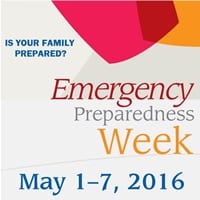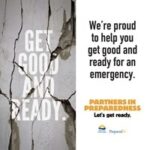It’s Emergency Preparedness Week – are you ready?

What’s more, if you’re feeling overwhelmed and the task of getting prepared keeps getting bumped to the bottom of your to-do list, we want to help you! One day, if a disaster strikes, being on the list won’t be enough. So today, we want to set you up for a week of preparedness. It’s just 5 simple steps. Choose one per weekday and by the end of the week you’ll be farther ahead than where you were at the beginning of the week.
5 Steps to Start Your Emergency Preparedness
- Visit GetPrepared.gc.ca – Canada’s online resource for emergencies. It’s packed full of information like how to make a plan, what hazards are in your area, how to plan for children, people with disabilities/special needs, and pets, what to put in an emergency kit. Get Prepared will also direct you to your Provincial or territorial emergency management organization (EMO). Familiarize yourself with your province or territory’s planning and research, training, response operations and the administration and delivery of disaster financial assistance programs in the event of an emergency. Your municipalities should also have resources available to you online.
- Gather your household together for an hour. Bring a pen and paper. Discuss the disasters that could potentially happen in your region, along with a list of everything you think you will need to gather (over time). This way, when you’re seeking to get prepared, you’ll have some guidance as to what purchases you need to make, and what procedures to follow. Develop your plan for responding to different emergency situations – Where will you meet? Does everyone in the household know where the emergency supplies are kept? Where will you meet if you’re all over town? If you have children – who can they go to in the neighbourhood if no one else is home, or if you’re injured and unable to direct them? A good guide like Jackie Kloosterboer’s My Emergency Earthquake Guide is another fantastic resource, and has applicable information to all emergencies, not just earthquakes.
- Make one purchase. Whether it’s an emergency kit for each household member, two weeks supply of water with a long shelf life, or freeze-dried food, you’ll be one step closer to being prepared, and maybe you’ll be motivated to do more sooner rather than later!
- Make a list of emergency contacts for your household, both local and out-of-province, and call them to let them know that you’ve chosen them as your emergency contacts. Make sure everyone in your household knows who these contacts are and how to reach them.
- Set aside an easily accessible space in your home, or an outdoor shed, for your emergency supplies. Gather everything that you already have in your home that could be useful. This may include flashlights, batteries, radios, an old cellphone that can call 911, lightweight camping gear… Think carefully, and only include what’s necessary.
If you complete all five of these tasks between May 1st and 7th, congratulations! And please feel free to make a comment below about what you learned during the process. If you started but weren’t able to finish, please don’t be discouraged. Instead, challenge yourself to do it next week, or the week after next! And remember to check back to see regular and relevant updates on our blog!






